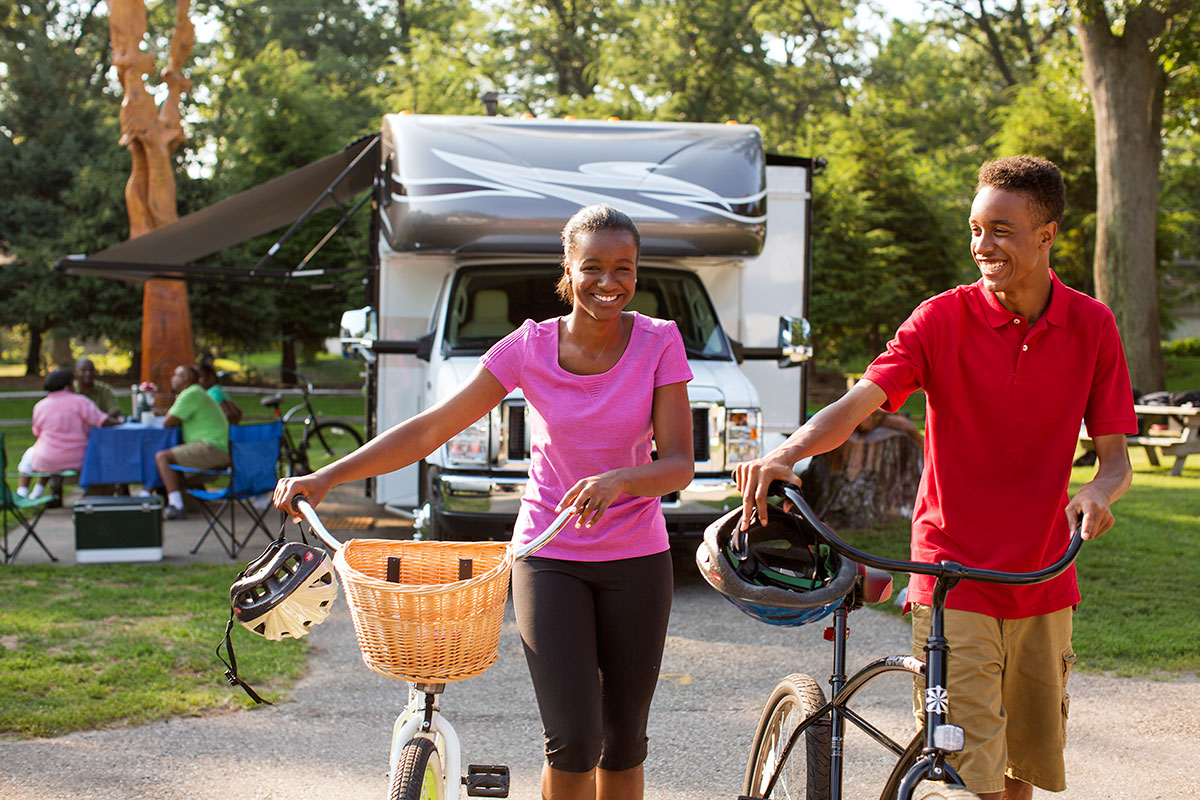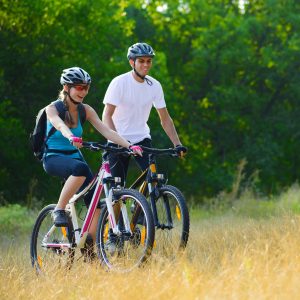What would camping be without bringing a bike along? For kids, bikes offer the freedom to roam the campground and grab an ice cream bar at the main office. For adults, they offer easy transportation and exercise. But bikes can be used for more than just pedaling around the campground. Michigan is home to the greatest collection and network of trails in the country: rail trails, mountain bike trails, the list goes on.
There are 1,300 miles of biking trails. Some cross the entire state while others remain within a state park or as a connection between towns. Bike trails can be urban or remote. Paved or dirt. The choice is up to you. In honor of #nationalbikemonth, here are some safety tips before you set off on two wheels.
- Prep your bike. Before you leave for your camping trip, or at least before your first ride at the campground or trail head, make sure your bike is in good working order. Check tire pressure, check the brakes and gears, make sure the water bottle holder is nicely in place. Make sure that reflectors are in place and not broken, and add a head light as well as a flashing tail light if you don’t already have them. Even during the daytime, these lights offer you more visibility by fellow bicyclists, drivers of vehicles (if you’re on a road), and others who share the trail or roadway (i.e., hikers). Add a bell or check that the one you have is still in working order.
- Get the gear. Wear a good helmet and make it a requirement for kids, no matter where they are riding. If you’ll be bringing along a pack of any kind to carry snacks, extra gear, etc., then choose a backpack as opposed to a messenger bag, which can swing around and take a toll on your shoulders. You can also utilize your bike frame in multiple ways by investing in a pannier. Sizes and prices vary. There are saddlebags, trunk racks, and packs that hang from your handlebars or even the main frame. You’ll also want a bike lock or alarm to place around your bike so that it doesn’t get stolen. Attach to a tree or even to the RV and through the back wheel to keep thieves at bay. Never leave your bike just lying about.
- Be prepared for emergencies. Just as with hiking, pack all the supplies you need in your bag in case of an emergency. A first aid kit, cell phone, a small bike pump, and an extra tire patch are all good items to have handy. Bring along snacks and, if you have room, some lightweight layers of clothing… just in case.
- Never bike under the influence. Even on the easiest route, you need to be paying complete attention so as to avoid from injuring yourself or someone around you. Biking under the influence of any mind-altering substance increases the risk of an accident. If you have a glass of wine or two, wait until you feel clear headed enough to continue on your way.
- Plan your route and a meeting point. You can research all of Michigan’s routes online, and maybe that’s why you’ve chosen a particular region or campground: to bike the nearby trails. But if you’re chosen for another reason and still enjoy a bike ride, then check with the front office for maps and recommendations. Hone in on your region using online sources: Michigan DNR or Eye on Michigan or Pure Michigan, among others. Find a trail that fits your experience, comfort level, and expected duration for the ride. If you’ll be riding with others, then always set a meeting point in case the group gets spread out or separated. Many of Michigan’s bike trails pass near or through towns, and some may want to peddle on while others want to meander around. Don’t rely on your phones. Pick a spot on the map and designate a time. If you’ll be riding on Michigan roadways with motorists, then stay on the right side to move with the flow of traffic. Additional safety tips can be found here.
Where should you go?
That’s a loaded question. Do you want to be going through towns? Do you want to be on a paved trail? Do you mind being on the road? How experienced are you? Some recommendations include:
- The Lakeshore Trail in Ottawa County on Lake Michigan has a lot of natural beauty and is generally rider friendly. The trail is 20 miles long, completed paved, and starts and ends at state parks.
- The Ludington Bicycle Trail runs along the Big Sable River. This is also paved.
- The VASA, location of the Iceman Cometh Challenge, near Traverse City has a couple options. There’s a more gentle trek and a technical single-track option.
- Marquette and Copper Harbor trail systems are the most well-known in the Upper Peninsula. These are meant for more experienced mountain bikers as the terrain can be quite challenging along some portions of the routes.
- The Pere Marquette Rail Trail that begins in Midland, near Michigan’s thumb, is 30 miles long and is extremely popular, attracting 200,000 visitors a year. The ride is full of outstanding landscapes and views.
- Mackinac Island, the state’s biking capital, has a paved trail that encircles the island. It’s just over eight miles long, is easy for any level of bicyclist, and passes by several natural formations of interest.


